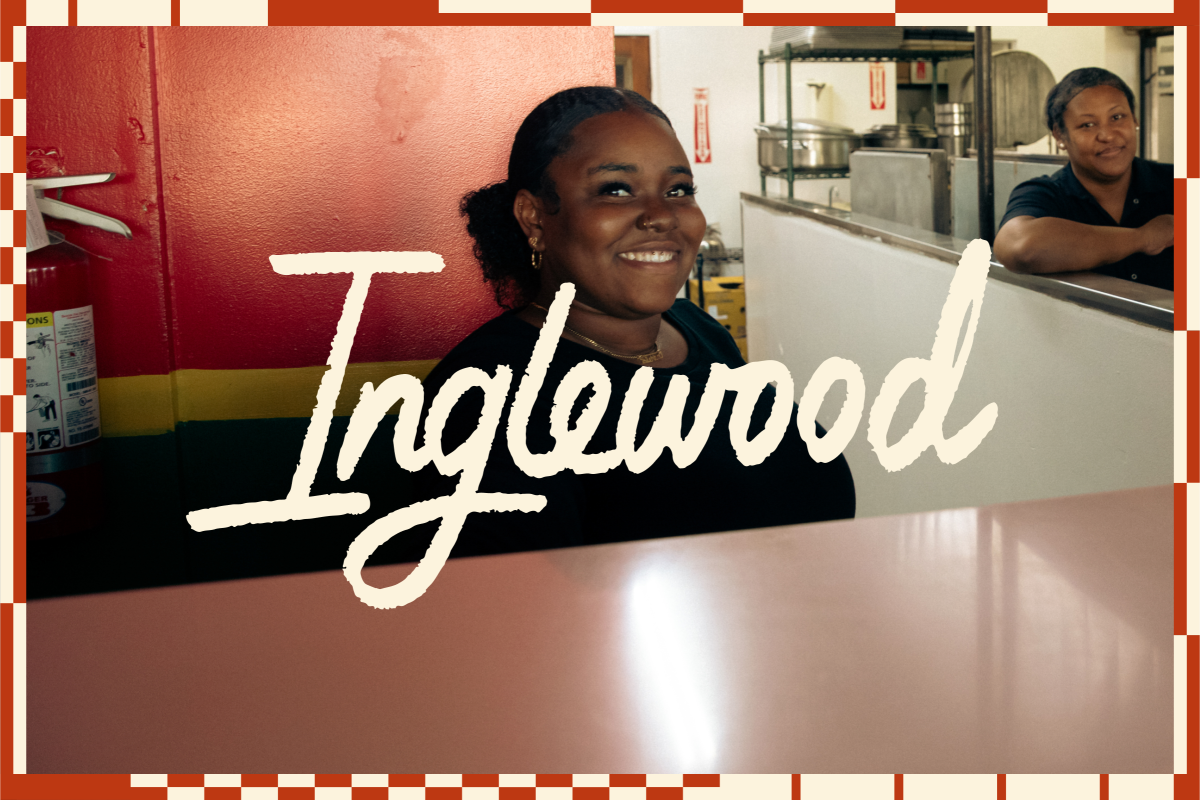‘Is this L.A.?!’ The surrealism of biking a car-free freeway
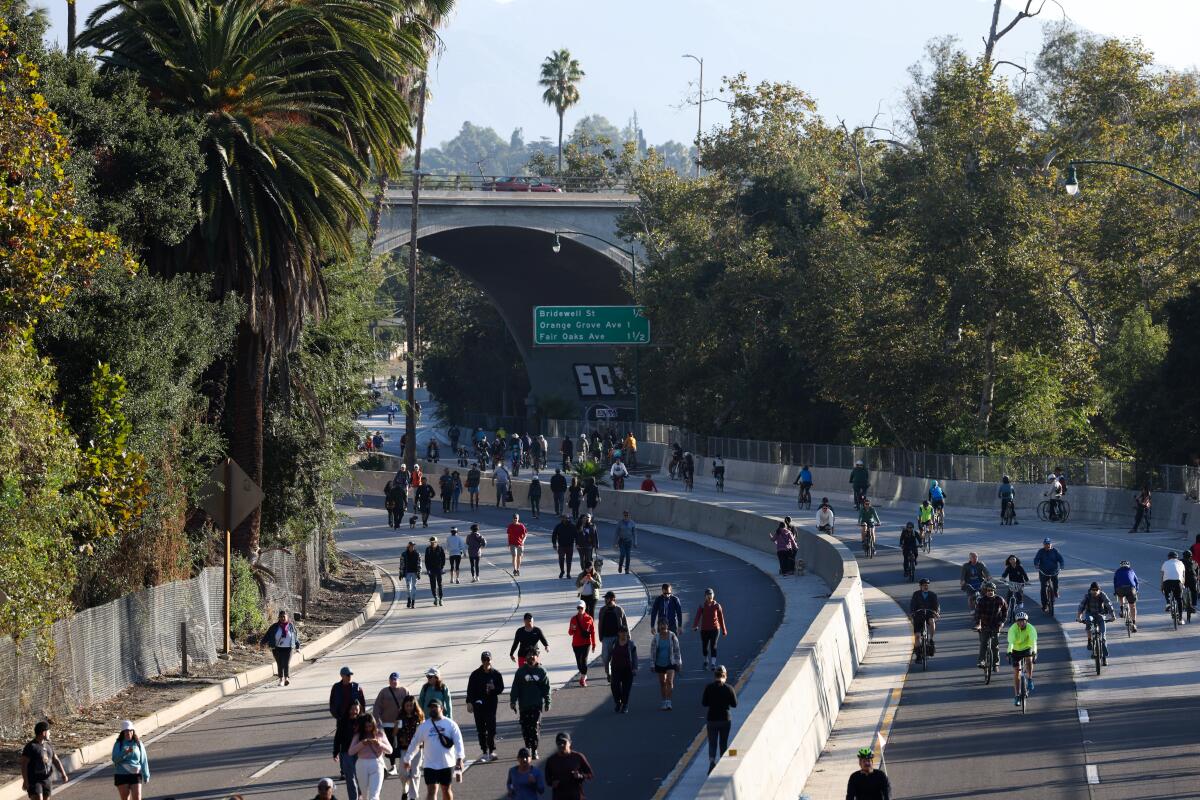
- Share via
Good morning. It’s Tuesday, Oct. 31. Here’s what you need to know to start your day.
- The surrealism of biking a car-free Arroyo Seco Parkway
- Remote workers moving out of California see loss of benefits
- The untold story behind the last Beatles song
- And here’s today’s e-newspaper
Sign up for Essential California
The most important California stories and recommendations in your inbox every morning.
You may occasionally receive promotional content from the Los Angeles Times.
Biking a car-free freeway
On Sunday, I joined tens of thousands of L.A. County residents on the historic Arroyo Seco Parkway. Typically, I’d be driving on this freeway. But on this morning, I merged onto the 110 in Pasadena on my bike.
This was ArroyoFest, a free event organized by Active San Gabriel Valley and presented by L.A. Metro. Six miles of the historic parkway was closed to cars from 7 a.m. to about 11 a.m., giving people a brief window to walk and roll along the roadway and explore the watershed that winds through the L.A. neighborhoods of Lincoln Heights, Cypress Park, Highland Park and Hermon, along with the cities of South Pasadena and Pasadena.
Those on bikes, skateboards, roller skates and other wheeled conveyances (including at least one towering unicycle) were designated the northbound lanes. People walking and running — including thousands who took part in a 110 10K — took the southbound side of the parkway.
As I biked up and down the car-free freeway, what stood out was the sound. It wasn’t that it was quiet, but that there was a richness to sounds normally drowned out by car traffic. I heard birds chirping, bike bells ringing, kids squealing with laughter and people talking with friends (I also heard that my bike chain could use a bit more grease).
And there was music, from personal speakers, bands performing near offramps or crammed in a stage being towed by tandem cyclists — and even a piano on wheels.
Traveling on a busy freeway isn’t typically a joyful experience, but this morning it filled the parkway. Attendees hollered with glee and stopped for selfies under massive green freeway signs and concrete archways.
“Is this L.A.?!” one passing cyclist asked no one in particular. For these precious hours, yes.
This event was a follow-up to the first ArroyoFest, which happened back in 2003.
Wes Reutimann, special programs director for Active SGV, told me the 2023 ArroyoFest was years in the making as organizers secured support from politicians and dozens of permits — most importantly from Caltrans.
Kelly Nomura and Nate Colon live in the South Bay and took Metro up to run a 10K on the freeway Sunday morning.
“It feels like a dream,” Nomura said. “Running on a freeway where we literally drive with our cars.”
Colon said he spends hours in freeway traffic each week and has sat in his car wishing he was on his bicycle instead. He planned to fulfill that wish after a post-run snack.
Even without cars, there was plenty of traffic on the freeway. After a breezy first hour on the bike side, the parkway began to fill with cyclists, bringing some gridlock and hectic maneuvering.
Clearly, there was heavy interest in ArroyoFest, which Reutimann called “a mixed blessing” when it came to how clogged the bike lanes got later in the morning. Organizers were expecting 40,000 attendees but won’t know the true number until they review video counters installed along the route. Some noted bad behavior from other cyclists during crowded conditions, which Reutimann said was a minority of visitors and believes spoke to the limited time frame people had to explore the parkway.
And though feedback was mostly positive, he noted that some people expressed frustration with organizers that the event ended as soon as it did.
“So many people have asked: ‘When’s the next one going to happen?’ because they had such a positive experience,” he said. “[It] was a magical day for a lot of people to spend time with their families and friends and just experience the historic parkway as a linear park and not just an expressway.”
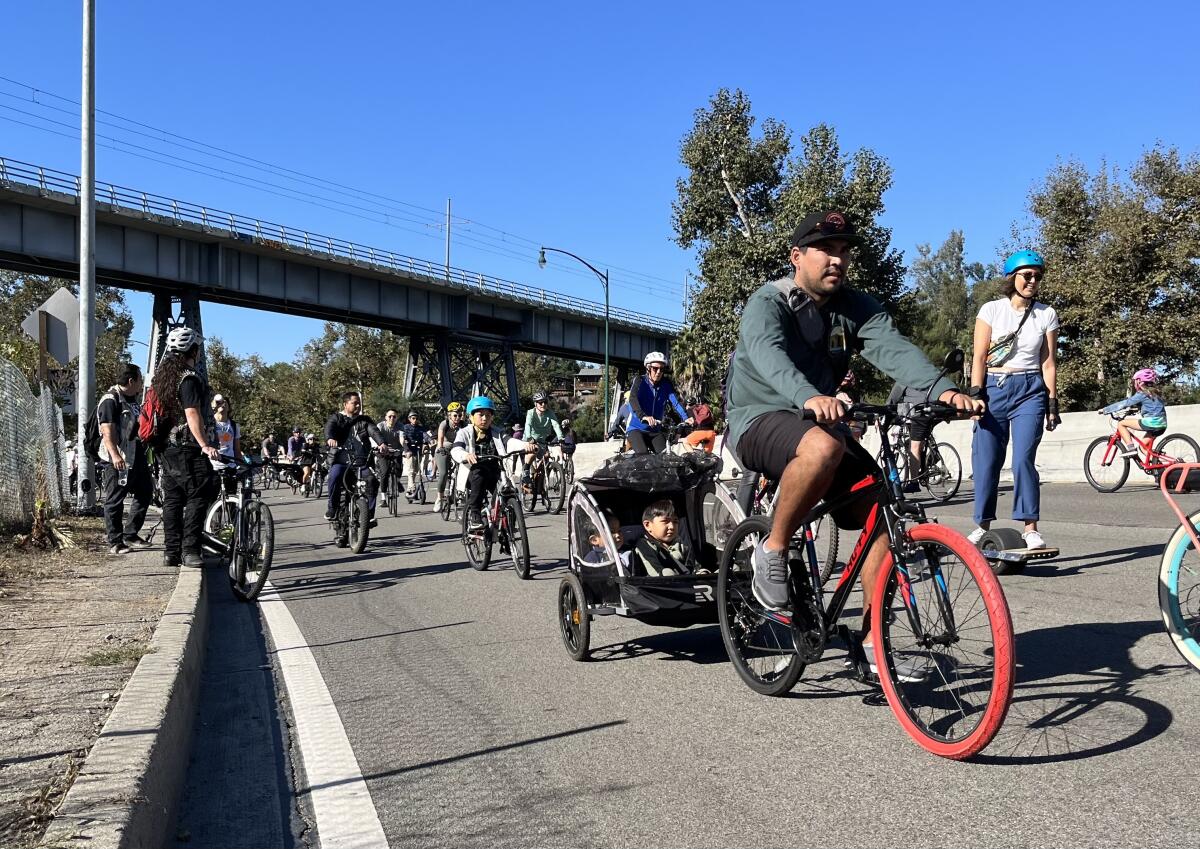
A cycleway, then a freeway, then (briefly) a cycleway again
The route was designed to be scenic, winding through hills and canyons and along a seasonal river with greenery and park space.
“Today the Arroyo Seco Parkway remains much as it was in 1940, even though it wasn’t designed for the speeds that motorists travel today,” California Historical Society archivist Wendy Welker wrote in a post detailing the history of the freeway.
That’s most notable in the infamous on- and offramps along the oldest sections of the freeway. If there’s a driving equivalent to taking off and landing a fighter jet on an aircraft carrier, this is it.
Here’s something else notable: this route long dominated by cars was first planned as a cycleway to connect Pasadena and Los Angeles. What was supposed to be a six-mile toll road for bicyclists got only about two miles in before construction stopped. A few decades later, the construction began on the Arroyo Seco Parkway, which officially opened to car traffic on Dec. 30, 1940.
South Pasadena resident Jennifer Trotoux grew up in the area and has been driving the 110 her whole life.
“I got tears in my eyes when I came down the onramp,” she said from her bike. “It’s just a beautiful way to see the city and see the community. … I feel like this is what it should be for.”
Married couple Matthew Shewfelt and Shannon Talbot live in Highland Park and came out to bike the parkway with their dog, Koufax.
“It makes you realize how much of an open space this is when you see how many people can fit on it, especially versus how many cars,” Talbot said.
Reutimann said the event gives residents a chance to experience the freeway more in line with its original purpose.
“Vehicles were … supposed to be traveling at much slower speeds than is the norm today,” he said. “And it was supposed to be just one element in a much more multimodal Los Angeles at the time.”
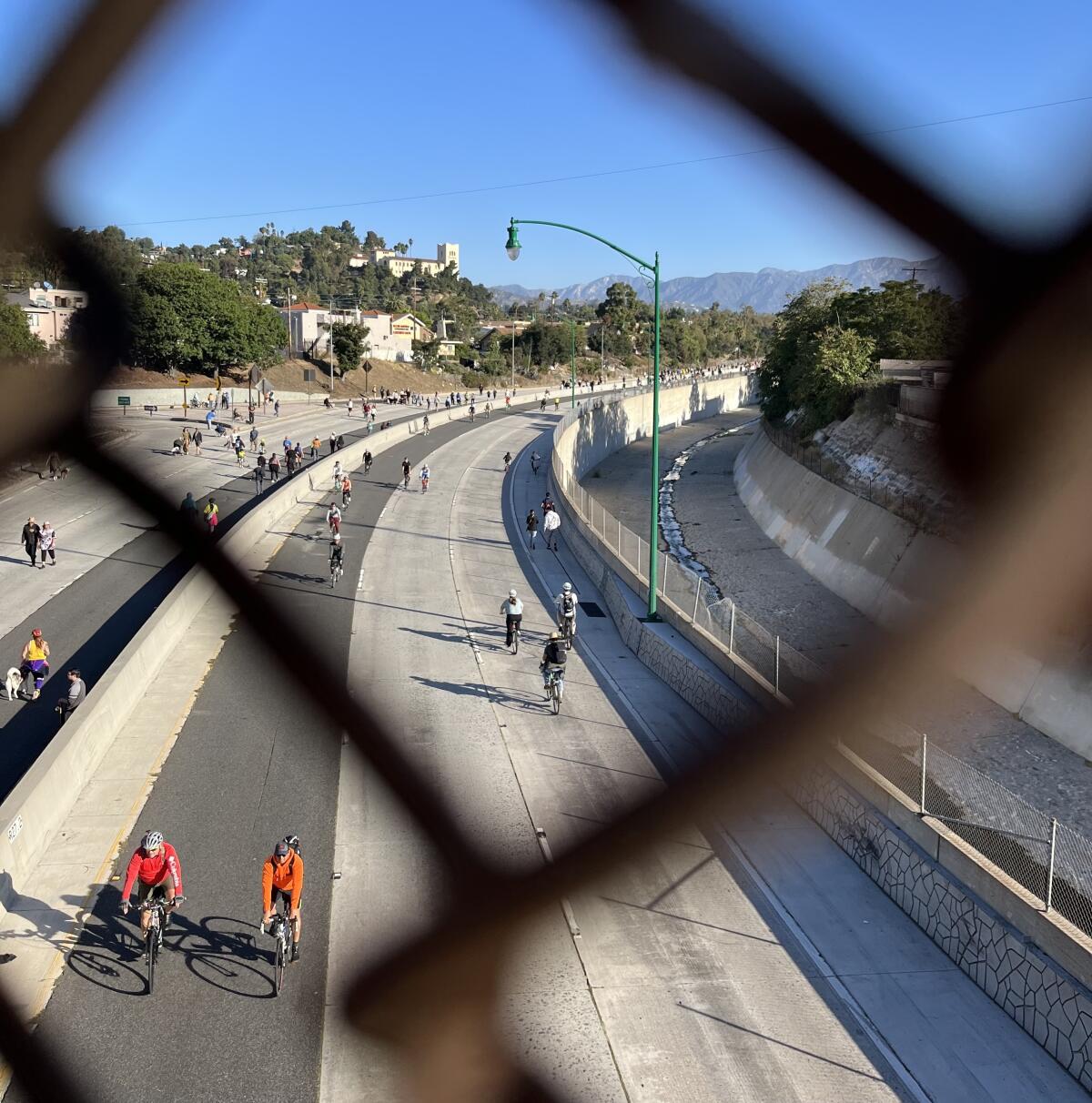
A world with fewer freeways
Most of us drive every day, commuting to — and through — neighborhoods that were bisected by this infrastructure decades ago and still feel the effects today. It was often communities of color that bore the brunt of freeway construction, as homes, schools, parks and more were seized and torn down to make way for concrete channels to accommodate car traffic.
In 2020, David S. Kim, then-secretary of Caltrans, acknowledged that the state’s “transportation systems” — government-speak for the state’s freeway network — “historically have disproportionately benefited certain segments of the population.”
“Far too often, past transportation decisions quite literally put up barriers, divided communities, and amplified racial inequalities, particularly in our Black and brown neighborhoods,” Kim said in a statement.
That racist history, along with growing concerns about the effects emissions from car-clogged freeways have on human health and the climate crisis, is fueling a movement to rethink how much space we’ve ceded to freeways — and wonder if tearing some down is the right way forward.
That debate surfaced most recently in Los Angeles with a proposal by community advocates to study the effects of dismantling the never-finished Marina Freeway and building housing and parks. But that’s unlikely to even be studied (Times columnist Erika D. Smith recently examined why).
And Caltrans, which approved the car ban that made ArroyoFest possible, had faced criticism for ongoing plans to widen freeways in the state, despite strong science that shows that it doesn’t actually solve our traffic problems.
For Reutimann and his fellow mobility advocates, transforming a space designed for cars into a route for people to walk and roll is a political statement. It speaks to Active SGV’s mission to help communities “become healthier, more livable, affordable and equitable places.”
“It’s really almost hitting pause on the status quo for a few hours on a Sunday morning and giving folks a glimpse of what the neighborhood [and] what our transportation system could look like if we made other modes have priority as well,” he said, “if we didn’t just put all our eggs in the automobile basket, which we’ve done to such a large degree.”
Today’s top stories
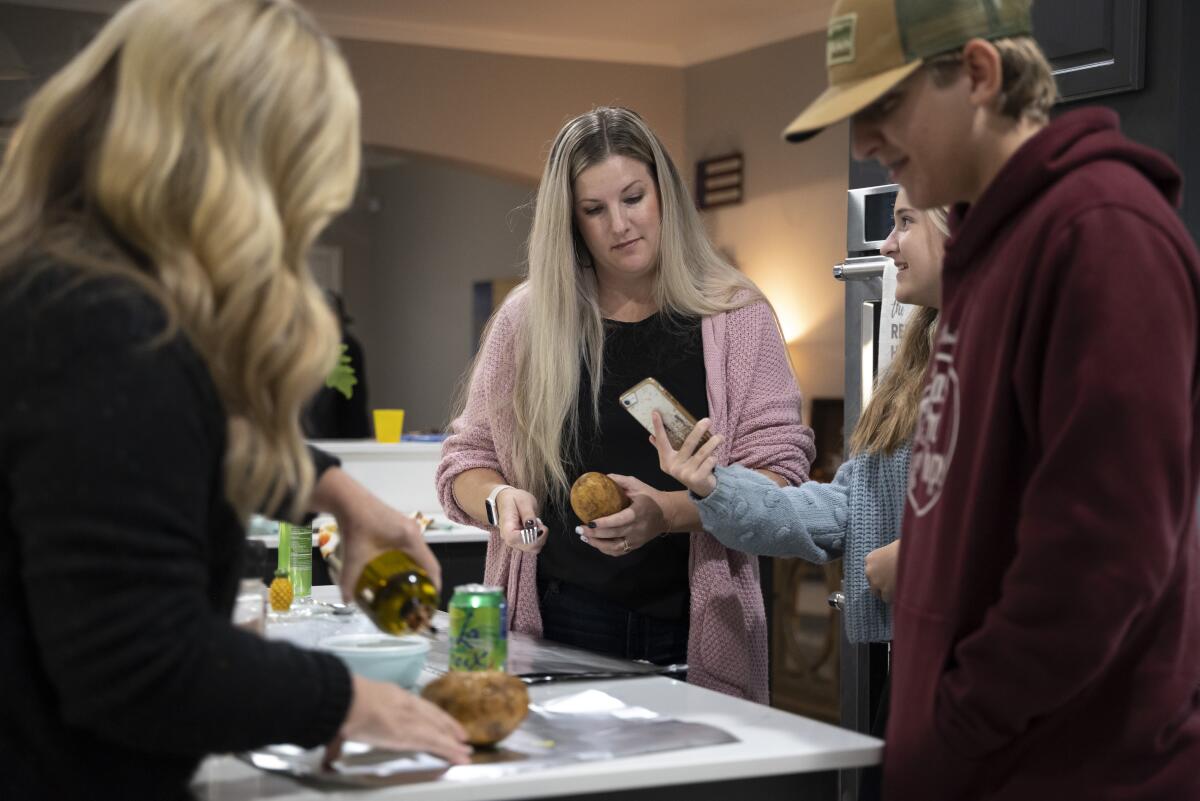
Business and labor
- The hidden costs for remote workers moving out of California.
- Are high interest rates stopping you from buying or selling a home?
- Megan Fox and Machine Gun Kelly snub SAG-AFTRA Halloween costume guidelines amid the strike.
Remembering Matthew Perry
- Matthew Perry’s ‘Friends’ co-stars react to his “unfathomable” death in a shared statement.
- Hank Azaria remembers Matthew Perry, his “first friend” in Hollywood and a guide into sobriety.
Sports
- Clippers finalizing deal to acquire James Harden in trade with 76ers.
- Three takeaways from Lakers’ comeback victory over the Magic.
- “She’s my superhero”: USC’s Calen Bullock honors his late grandmother through his play.
- Magic Johnson reaches billionaire status. He joins Michael Jordan, Tiger Woods and LeBron James.
More big stories
- Californians with past-due water bills can get help with payments. Here’s how.
- Manhunt for Maine shooter kept them apart. Now they can finally come together to grieve.
- What the U.S. is telling Israel about a Gaza ground invasion — and what Israel is hearing.
- A young Israeli festivalgoer’s death is confirmed, shining a light on families’ long ordeal.
- The BMW driver accused of killing four Pepperdine students is out on a $4-million bond.
- 9th Circuit stays a ruling against California’s assault weapons ban, pending an appeal.
- Small fires ignite as Santa Ana winds raise the danger of quick-moving flames.
- “Beyond blessed”: Mary Lou Retton provides an update on her recovery from pneumonia.
- Hate crimes and hate speech are on the rise in India. Meet the trackers.
- How “outlier” filmmaker C.J. Obasi became Nigeria’s new Oscar hopeful.
- David Fincher “not responsible” for incels co-opting “Fight Club”: “We didn’t make it for them.”
Get unlimited access to the Los Angeles Times. Subscribe here.
Commentary and opinions
- Jonah Goldberg: Will the media get coverage of the crisis in Israel and Gaza right? It all depends on the editors.
- Bill Plaschke: No lie, James Harden joins Clippers as the right player at the right time.
- Michael Hiltzik: American unions have finally remembered how to win.
- Bill Shaikin: Why MLB is in danger of making an Olympic-sized blunder with the 2028 L.A. Games.
- Opinion: H.G. Wells’ alien-invasion novel is night-before-Halloween scary. But it’s a lot more too.
- Kevin Baxter: The World Cup hosting battle between Stan Kroenke and FIFA goes way beyond the field size.
Today’s great reads
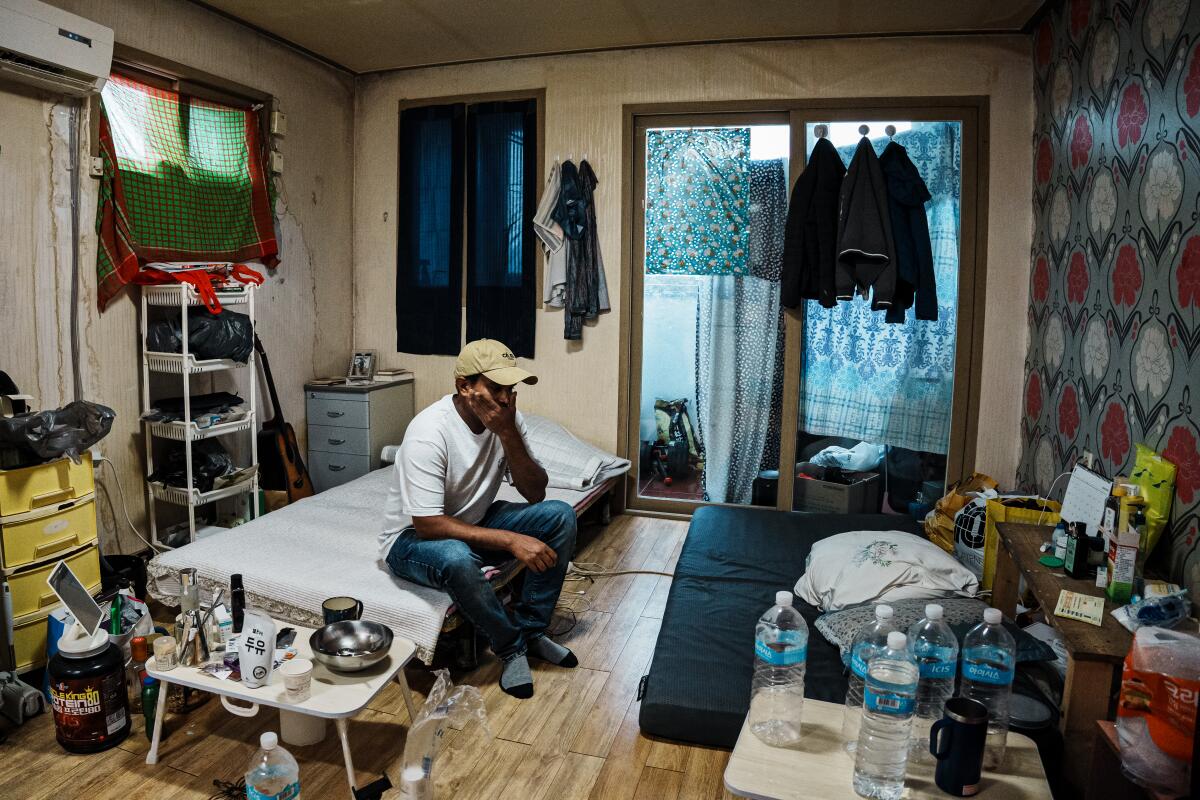
Facing a labor crisis, South Korea turns to migrants. Why are they more likely to die on the job? Criticism has focused on the powers the country’s migrant program gives to employers, which makes it difficult for migrants to seek other jobs or protest unsafe working conditions.
Other great reads
- Monarch butterflies appear to be everywhere these days. Is the crisis over?
- Is “90 Day Fiancé” having an effect on visa approvals? A new report argues it is.
- The untold story behind the last Beatles song.
- How brujas use spirituality to honor the ancestors on Día de Muertos.
How can we make this newsletter more useful? Send comments to [email protected].
For your downtime
Going out
- 🍩 For visitors, Inglewood is their introduction to L.A. and perhaps the West Coast. For Angelenos, it’s the final sign of a safe journey home. Explore the neighborhood with our guide.
- 🖼️ Phranc opens“The Butch Closet“in Santa Monica. It’s queer life meticulously documented in cardboard.
- 📚🍷 “Book people are my people”: Why your next vacation should be a book retreat.
- 🥧 This purple ube pie from Baking with Ish is among our columnist Jenn Harris’ must-haves for the holidays.
Staying in
- 📺 A new streaming service will offer Lakers games to cable cord-cutters.
- 📙 She was told her grandfather had saved a Black man. Then she dug up the ugly truth.
- 🧑🍳 Here’s a recipe for a tropical mole for Día de Muertos.
- ✏️ Get our free daily crossword puzzle, sudoku, word search and arcade games.
And finally ... a great photo
Show us your favorite place in California! Send us photos you have taken of spots in California that are special — natural or human-made — and tell us why they’re important to you.
Today’s great photo is from Frank Damon of Pacific Palisades: Ventura Harbor. Frank writes:
Ventura Harbor is a wonderful place which has many boats docked there, terrific restaurants in the adjoining village, and the visitors center for Channel Islands National Park, along with a large map of the park. It is a quick drive from Los Angeles and a great place to spend a weekend any time of year.
Have a great day, from the Essential California team
Ryan Fonseca, reporter
Elvia Limón, multiplatform editor
Kevinisha Walker, multiplatform editor
Laura Blasey, assistant editor
Check our top stories, topics and the latest articles on latimes.com.
Sign up for Essential California
The most important California stories and recommendations in your inbox every morning.
You may occasionally receive promotional content from the Los Angeles Times.
